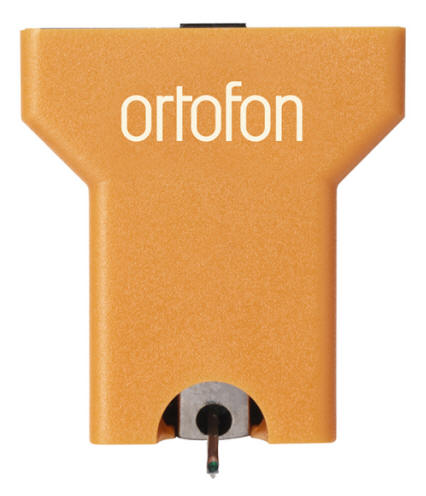|
|
You are reading the older HTML site
Positive Feedback ISSUE 78
ortofon Quintet Bronze Cartridge as reviewed by John Hoffman
In the realm of human perception colors are strictly a visual phenomenon. While the cones and rods in our eyes are responsible for the hues and shades of color we see, there is also emotional component to this scattered reflection of light we experience. Bright primary colors such as red, blue, and yellow are often associated with positive emotions, while dark shades such as brown, black, or gray portray the feelings of a somber and restrained existence. This element of color is an innate part of human experience, and it is no surprise that we use it to define many facets of our lives. These definitions can be contradictory, such as a red flame on a placard indicating danger of fire. Yet red hair on a person can be indicative of a passionate soul with a zest for life. All of these diverse meanings associated with color seem second nature to us, and we intuitively understand them. So it becomes no surprise that in recent years Ortofon has employed a color system in the new lines of cartridges it releases, and as hobbyists we have an appreciation to the sense of order it provides. Ortofon introduced the new color system in 2005 with the Rondo series of cartridges. From top to bottom the cartridges were ranked in the order of Red, Blue, and Bronze. In 2007 these colors were used with the new 2M series of cartridges, and expanded to include the now top of the line Black designation. Within the 2M series the Red is the introductory cartridge, and then comes the Blue. The next step is the 2M Bronze, and the cartridge at the pinnacle is the Black. This ranking system was then implemented when the Cadenza cartridges were released, and have been carried over to the new Quintet series of moving coil cartridges. The Quintet cartridges have superseded the Ortofon Rondo moving coil, which had a nine year run in the market. While the fundamental Rondo moving coil architecture lives on in the Quintet cartridges, there are significant improvements that have been implemented in these cartridges. Actually the Rondo traces its existence back to the Ortofon MC 10/20/30 series of moving coils, but the design has gone through such an extensive evolution that it is difficult to recognize those shared traits that still remain. Putting the history of the Quintet cartridges aside for the time being, it is time to focus in on the latest house guest to make its way onto my turntables. The Quintet Bronze has spent the last few months on both of my tables, and has redefined what I thought an affordable moving coil cartridge from Ortofon is capable of. From my past experience Ortofon cartridges have been remarkably detailed, with a somewhat cool tonal balance. I will say this description does not describe the Quintet Bronze in any way at all, and that this cartridge will appeal to a different type of listener that previous Ortofon designs may not have.
The Quintet Bronze is a low output moving coil that sells for $839. The output voltage is .3mv, so it is necessary to have a phono stage that can provide approximately 65dB of gain. Alternatively, a step up transformer can provide enough additional gain to allow the Quintet to run on a phono stage designed with moving magnet cartridges in mind. The Quintet body is made from a combination of ABS thermoplastic and aluminum, which creates a light and stiff housing that is resistant to structural resonances. The shape of the cartridge body is composed of straight lines and right angles, which aides in the cartridge installation by providing additional visual cues to sight with a cartridge alignment protractor. The bodies are tapped for threaded bolts, which simplifies the mounting process. All of the cartridges in the Quintet family use neodymium magnets, and are designed with low internal impedance which allows them to be used with a wider range of phono stages. The coils are wound from 4-nines copper. There are differences in the coil architecture and the coil wiring material in the Quintet Bronze/Black cartridges as compared to the Red/Blue models. This can be seen by the lower output voltage of .3mV of the upper tier cartridges versus the .5mV of the two lower rung ones. The Bronze cartridge uses a nude mounted fine line diamond on an aluminum cantilever. The tracking force range is 2.1 to 2.5 grams, with the recommended force being 2.3 grams. The dynamic compliance measures at 15 µm/mN, so this is a medium compliance cartridge that will work well on a wide variety of tonearms. The Quintet Bronze spent equal portions of time on my Galibier Audio Serac with the Riggle Engineering 12" String Theory arm, and a restored Thorens TD 124 with a Eminent Technology II linear tracking arm. Despite their differences in architecture and being produced 40 years apart, these tables sound more similar than different. The Serac reaches a bit deeper in the bass, while the Thorens coupled with the linear tracking air bearing arm has an remarkably low noise floor. Tracking force was set at 2.3 grams, and while I experimented in the published force range, I ended up returning to setting recommended by Ortofon. The phono stage used with these tables is the Liberty Audio B2B-1, which I configured for a 220 ohm load for this cartridge. An Electra Print PVA pre-amplfier and 300B Custom amplifier drove a pair of Hawthorne Audio Trio speakers. Power conditioning duties were handled by an Audio Magic Mini-Reference, and all cabling came from the Zu Audio Mission series of wire. One discrepancy in the Ortofon color scheme has always been stuck in the back of my mind, and I have never been able to successfully resolve why it exists. Three of the four colors used are primary colors, and then we have Bronze. Why is it different? Technically Bronze is not a color in itself, but rather a metal that is an alloy of copper, tin, and a small portion of aluminum. Or perhaps more historically minded folks would be more inclined to reference the Bronze Period, where notable advances in civilization were made possible due to the improved goods created from the metal. Then again, maybe it is just a color that reflects the effects of sun drenched rays found in exotic island locales. Perhaps only those principals at Ortofon know the real reason for the inclusion of this odd color, although I will say that it aptly describes the voicing of this particular cartridge. As I mentioned earlier, the Quintet Bronze does not sound anything like previous Ortofon cartridges. Over the years I have owned the MC 20 Super, MC 30 Super, MC25FL, and a couple of the X series cartridges. To one degree or another these cartridges were detailed, although everyone of them had a cool tonal balance to one degree or another. The Bronze is rich, textured, refined, with a full bottom end that fleshes out the bass passages. If there is a limitation to this cartridge, it is in the manner of how it handles the fine detail of the recording in the higher registers. While the Bronze is not opaque or lackluster by any stretch of the imagination, it does prefer a stately presentation of music over unveiling the finest of details buried in a recording. In short, this is a music lovers cartridge, but let us delve into some vinyl in order to have a clear picture of what the Bronze is capable of. The Quintet Bronze presents harmonic texture superbly, especially when one factors in its reasonable price point. Instruments have remarkable density and warmth, yet still retain the subtle detail and shadings that breathes life into the music. On "Three to Get Ready" from the Dave Brubeck Quartet [Time Out; Columbia CS8192] I was thoroughly impressed with the delicate expression and easy flow of the saxophone passages. The brush work on the drums had an underlying rasp to it yet still sounded smooth and soft. All of the drum work sounded inherently real. The piano passages came through nicely on this cartridge, with great tone, and a realistic decay to the notes. The lowest bass passages were tight and extended with a solid feel to every plucked string. Yet when the notes were held longer and allowed to decay, it was easy to hear the slightly hollow feel of the body of the stand up bass. Historically speaking, moving coil cartridges with remarkable tone and texture usually flow from the artisan designers of small Japanese manufacturers. Yet that is what the Quintet Bronze reminds me of, and it is a presentation that I have never experienced from the affordable level of Ortofon cartridges. For those people who value harmonic density and texture, this is a cartridge you should experience. This discussion of the harmonic texture and tonal density segues neatly into the question of how the Quintet Bronze handles vocals. In reality, both of these subjects are closely related, and it is not a surprise that this cartridge also excels in this area. The album Rumours by Fleetwood Mac has always been a favorite of mine, and I do not know if I can ever tire of listening to "Dreams". [Rumours; Reprise 517787-1] The double 45 RPM offering from Reprise records is a gem of a recording, and I take it out for a listen every time a piece of new analog gear finds its way into the house. The Bronze works it magic on Stevie Nicks lead vocals, as it perfectly portrays the dark and introspective feel that is woven through this song. Christine McVie and Lindsay Buckingham background vocals are stellar also, infused with feeling and emotion that is often missed by lesser phono cartridges than the Quintet Bronze. As a side note, the bass guitar and kick drum opening on this song are just wicked in terms of the physical impact they impart. While these instruments are pushed forward in the mix, the Ortofon cartridge does a fine job of keeping the sound tight and focused. This is especially true when I had the cartridge mounted up on the Galibier Audio Serac, as this table and arm combination provides a wonderful venue for the Bronze to showcase its bass performance. While this discussion of bass prowess is a bit off the main topic of this paragraph, the Quintet did such a remarkable job I felt it important to include it in this discussion of the song. I will endeavor to keep this article moving down the straight and narrow path as we move forward. Another area where the Quintet Bronze excels in is its ability to present the dynamic scale of music at a macro level. Large scale or high intensity works sounds big, brash, and bold. The Bronze is no mamma's boy cartridge, that is a fact. Two For the Show is a double live album that Kansas released at the zenith of their career. Side two opens up with "The Portrait", which the band dialed up the tempo for the concert. [Two for The Show; Kirschner Stereo PZ2 35660] The crowd is chanting and clapping, the kick drum pounding out a beat, and then the band steps on the throttle, belting out a classic Kansas song. Everything from the electric guitars, bass, synthesizers, electric violin, or the signature vocals of lead singer Steve Walsh is alive and completely engages me as a listener. The Quintet Bronze brought all the energy contained in that massive wall of sound that Kansas could bring to a live performance. The scale of the sound was never greater than what the Bronze could handle, and in the midst of this whirlwind of music, this cartridge still relayed all the fine details and nuances of instruments and performers that were woven through these pieces. You see Kansas was a progressive rock band at heart, and the deep tracks on their albums were often far more musically complex than the hits that received extensive radio play. This ability to convey dynamic expression extends far past this rock and roll album, and I spun records from Wagner, Count Basie, Depeche Mode, and a few other genres of music. In every case the Quintet Bronze turned in a stellar performance in terms of presenting the energy and scale of an album. Ortofon voices the Bronze series of cartridges to be robust and full in the bass, nicely textured in the midrange, and refined in the upper registers. These defining attributes extends across all the family lines that use the color designations. The Quintet series is the first tier in Ortofon's low output moving coil offerings, so it makes sense that these cartridges have a bit more personality that will imprint itself on the music. In contrast, the next tier up in the Ortofon lineup is the Cadenza series, which is more evenly balanced, and reveals the subtle nuances of music that is so difficult to achieve. The Quintet Bronze also has these kinds of qualities, although to a lesser degree. Also the upper registers are not as detailed and defined on the Quintet Bronze as compared to the Cadenza. Certainly you would expect this with a $1000 plus price difference between the two cartridges, yet it is still a remarkable feat that the less expensive sibling can bring all the important qualities of the Bronze family sound to the party. The opening passages of "Poetry and Passion" [Secret Luminescence; Private Music 2021-1-P] by Lucia Hwong contain chimes, haunting wooden flutes, delicate piano phrases, and wooden percussion notes that sound like falling rain. The Quintet Bronze turns in a solid performance on this song, and there is nothing fundamentally wrong about how this sounds. Yet compared to the top tier low output moving coil cartridges on the market, it does lack that ability to present the finest of details in the upper registers that enhances the illusion of listening to a live performance versus a recording. I want to reiterate this point, the Quintet Bronze is not rolled off or subdued in the top end at all. Rather it just does not get that last level of detail that the upper tier moving coil cartridges can convey, such as the Cadenza Bronze. When taken as a whole package, the Quintet Bronze is a remarkable cartridge that excels in so many ways, even if it does imprint a bit of its personality on the music. Ortofon has been in the business of sound reproduction since 1918, and along the way they have learned a thing or two about how to build a phono cartridge. Some of the finest cartridges that have ever been produced come from this company, yet they are a full service manufacturer whose product line spans the needs of the market from top to bottom. For instance, the OM series of moving magnet cartridges set the standard as an affordable high performance choice for years, and its replacement in the 2M series of cartridges is carrying on in the same manner. The Quintet series of cartridges builds on the knowledge that Ortofon has acquired over the years, and is the latest example of what is possible when a company with formidable resources at its disposal sets out to build an affordable high performance product. The Quintet Bronze is a remarkable cartridge that incorporates first rate materials with an overall design philosophy that is targeted at meeting the needs of those who appreciate an exuberant and earthy presentation of music. This cartridge excels at getting the texture and tone of the music right, and in doing so is able to convey the emotional expression of the works in a way that many mid-priced moving coil cartridges cannot equal. The Bronze is not about an aural fireworks display that dazzles the listener. Rather, this cartridge creates a comfort and familiarity for a person in the way a favorite coat or set of gloves can provide on a frigid winter day. The ability to make a direct connection to the music is what defines the Quintet Bronze, and is what justifies spending several hundred dollars on this cartridge. I can certainly recommend searching out the Quintet Bronze and giving it a careful evaluation, as you may find its distinctive charms are capable of satisfying your long term analog desires. John Hoffman
Ortofon Quintet Bronze Cartridge
Ortofon |













